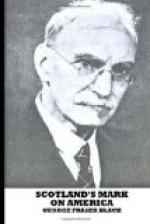George Rogers Clark (1752-1818), to whose prowess is due the possession of the territory Northwest of the Ohio, secured by the peace of 1783, was of Scottish descent. David Crockett (1786-1836), was most probably of the same origin, though vaguely said to be “son of an Irishman.” The name is distinctly Scottish (Dumfriesshire). Samuel McDowell (1735-1817), took an active part in the movement leading to the War of Independence and was President of the first State Constitutional Convention of Kentucky (1792). Colonel James Innes, born in Canisbay, Caithness, was appointed Commander-in-Chief of all the forces in the expedition to the Ohio in 1754 by Governor Dinwiddie.
Isaac Magoon, a Scot, was the first settler of the town of Scotland (c. 1700), and gave it the name of his native country. Dr. John Stevenson, a Scot, pioneer merchant and developer of Baltimore, if not indeed its actual founder, was known as the “American Romulus.” George Walker, a native of Clackmannanshire, pointed out the advantages of the present site of the Capital of the United States, and George Buchanan, another Scot, laid out Baltimore town in 1730. John Kinzie (1763-1828), the founder of Chicago, was born in Canada of Scottish parentage, the son of John MacKenzie. It is not known why he dropped the “Mac.” Samuel Wilkeson (1781-1848), the man who developed Buffalo from a village to a city, was of Scottish descent. Alexander White (1814-72), born in Elgin, Scotland, was one of the earliest settlers of Chicago and did much to develop the city. Major Hugh McAlister, who served in the Revolutionary War, later founded the town of McAlisterville, Pennsylvania, was of Scots parentage. James Robertson (1742-1814), founder of Nashville, Tennessee, was of Scottish origin. His services are ranked next to Sevier’s in the history of his adopted state. Walter Scott Gordon (1848-86), founder of Sheffield, Alabama, was the great-grandson of a Scot. The town of Paterson, in Putnam county, New York, was settled by Matthew Paterson, a Scottish stone-mason, in the middle of the eighteenth century, and was named after him. Lairdsville, in New York state, was named from Samuel Laird, son of a Scottish immigrant, in beginning of the eighteenth century. Paris Gibson (b. 1830), grandson of a Scot, founded and developed the town of Great Falls.




